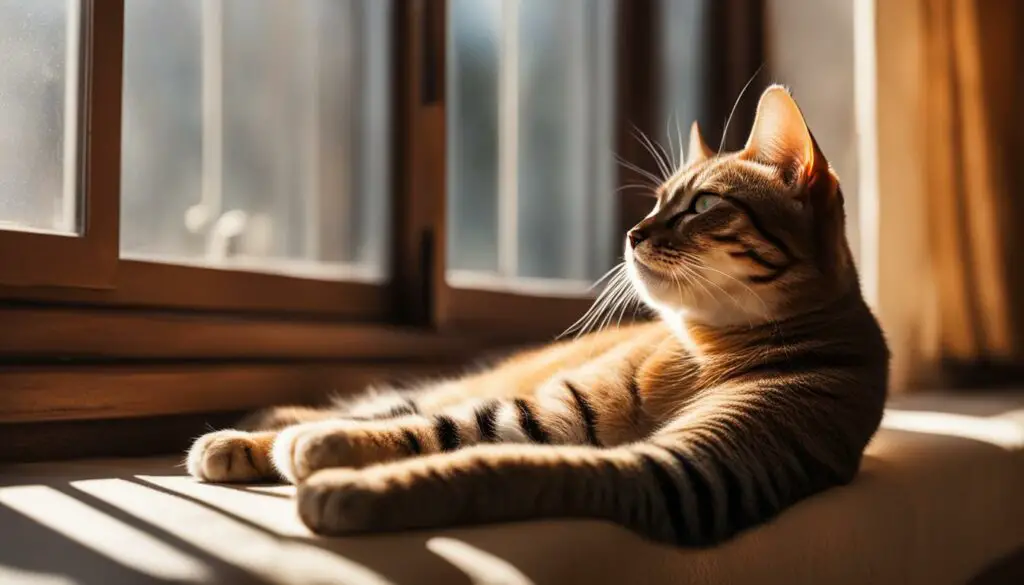Have you ever noticed your cat sighing and wondered what it means? As a cat behavior enthusiast, I’ve done some research to help you understand this fascinating feline behavior. Cats sigh for various reasons, and it’s important to decipher their messages to ensure their well-being and happiness.
Key Takeaways:
- Understanding cat behavior is crucial for pet owners to create a harmonious bond with their feline friends.
- Cats sigh as a way to communicate their emotional state, including relaxation, contentment, and boredom.
- Sighing is generally a normal behavior and not indicative of any underlying health issues.
- Providing mental stimulation and a stimulating environment can prevent excessive sighing due to boredom.
- It is important to pay attention to other signs and behaviors to fully understand a cat’s emotional well-being.
Cats Sigh for Relaxation and Contentment
Cats are known for their ability to find tranquility in any situation. When a cat is relaxed and content, they often express it through sighing. Sighing is a deep breath followed by a slow exhale, signifying a state of peace and calm. It is a natural behavior that allows cats to release tension and show their comfort.
Sighing can occur at various times throughout the day. Cats may sigh before or after sleep, during periods of rest, or when they are simply enjoying a moment of leisure. It is their way of letting go of any stress or anxiety, and fully immersing themselves in their surroundings.
| Signs of Relaxation and Contentment in Cats | Example |
|---|---|
| Soft, relaxed body posture | Cat lying on their side, with their paws tucked underneath |
| Purring | Cat purring while being gently stroked |
| Slow blinking | Cat closing their eyes halfway and maintaining eye contact |
| Kneading | Cat gently pressing their paws into a soft surface, like a blanket |
| Contented vocalizations | Cat making soft, melodic sounds |
It is important to create an environment that promotes relaxation and contentment for your cat. Providing comfortable resting spots, interactive toys, and quality time for bonding can contribute to their overall well-being. Remember, a sighing cat is a happy cat!
Sighing as a Sign of Boredom
Cats may also sigh when they are bored. If a cat has nothing to do and is lying around, sighing may occur. Boredom can lead to destructive behaviors, so it is important to provide cats with mental stimulation to prevent boredom and excessive sighing.
To alleviate boredom in cats, it is recommended to provide them with interactive toys and activities. Puzzle toys that require problem-solving and treat-dispensing toys can engage their minds and keep them occupied. Additionally, providing vertical spaces such as cat trees or shelves allows cats to climb, jump, and explore, providing both physical and mental stimulation.
Table: Cat Mental Stimulation Ideas
| Activity | Description |
|---|---|
| Puzzle Toys | Toys that require cats to figure out how to retrieve treats or toys from hidden compartments. |
| Interactive Wand Toys | Toys that simulate prey-like movements, encouraging cats to chase and pounce. |
| Window Perches | Platforms attached to windows that allow cats to observe the outside world and engage with the sights and sounds. |
| Clicker Training | A positive reinforcement training method that encourages cats to learn tricks or commands. |
| Secure Outdoor Enclosures | Outdoor spaces designed specifically for cats, allowing them to experience the outdoors safely. |
By providing cats with opportunities for mental stimulation, owners can help keep their feline friends entertained and prevent excessive sighing due to boredom. It is important to observe a cat’s preferences and adjust the activities accordingly to ensure they are mentally engaged and happy.
Sighing as a Normal Behavior
When it comes to cat behavior, sighing is a normal and natural occurrence. Cats may sigh as part of their regular relaxation routine, indicating that they are content in their environment. It is a sign that they are feeling relaxed, comfortable, and at ease.
Sighing is one of the ways that cats express their emotions. Just like humans, cats have their unique ways of communicating, and sighing is one of the vocalizations they use to convey their state of mind. When a cat sighs, it is a gentle release of tension and can often be seen during periods of rest or leisure.
As a cat owner, it is important to understand that sighing is a normal behavior and not a cause for concern. It is simply a way for cats to express their contentment and relaxation. However, it is always a good idea to pay attention to other signals and behaviors in conjunction with sighing to get a complete picture of your cat’s emotional well-being.
| Normal Cat Behavior | Sighing |
|---|---|
| Purring | A sign of contentment and happiness |
| Kneading | Expresses comfort and relaxation |
| Tail wagging | If done slowly and gently, can indicate relaxation |
| Stretching | Shows comfort and satisfaction |
“Sighing is a normal behavior for cats, which signifies their relaxation and contentment. It is a way for them to express their emotional state and should be seen as a positive indication of their well-being.” – Dr. Emily Thompson, Feline Behavioral Specialist
In summary, sighing is a normal behavior for cats, similar to other signs of contentment and relaxation. It is not usually a cause for concern and does not indicate any underlying health issues. Understanding and acknowledging this normal behavior can help deepen the bond between cats and their human companions.
Loud Sighing in Cats
While sighing is a normal behavior in cats, some may sigh more loudly than others. This variation in vocalization is usually not a cause for concern. In fact, loud sighing may indicate that a cat is particularly relaxed and comfortable in its environment. When a cat sighs loudly, it is an audible expression of their contentment and relaxation.
Just like humans, cats have individual ways of expressing themselves, and some may simply be more vocal than others. Loud sighing can be seen as a positive sign that your cat feels safe, secure, and at ease in their surroundings. It can also indicate that they are enjoying a moment of deep relaxation or contentment.
So, if you notice your cat sighing loudly, there’s no need to worry. It’s simply a variation in their vocalization and a reflection of their overall well-being. Embrace their unique way of communicating, and continue to provide them with a comfortable and enriching environment.
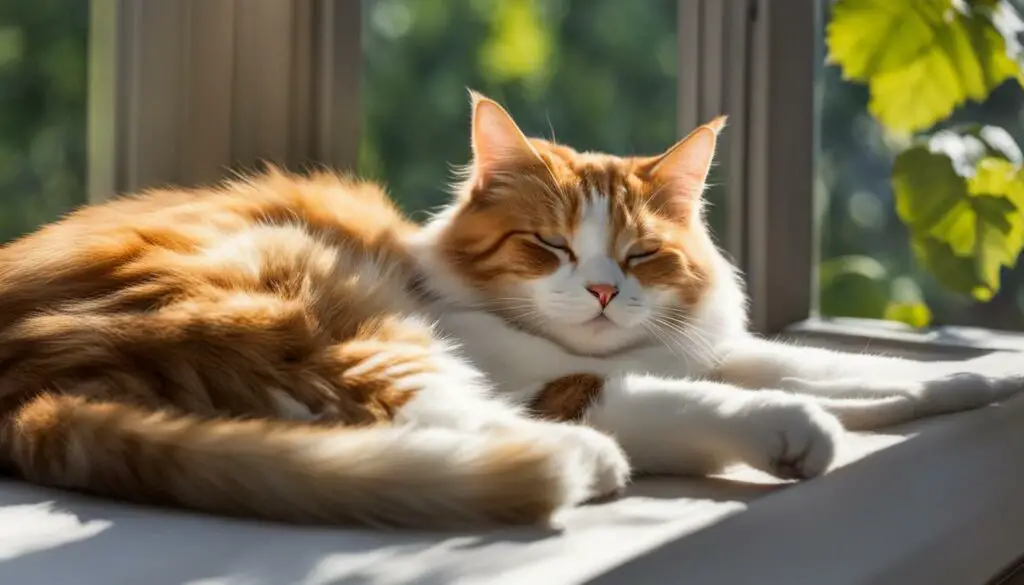
Additional Peaceful Moments: Tips for Creating a Relaxing Environment for Your Cat
- Provide cozy resting spots: Set up comfortable beds or blankets in quiet areas of your home where your cat can relax.
- Create a safe space: Designate a specific area where your cat can retreat to when they need some alone time.
- Offer environmental enrichment: Provide interactive toys, scratching posts, and climbing trees to keep your cat mentally stimulated and entertained.
- Establish a routine: Cats thrive on consistency, so try to stick to a regular schedule for feeding, playtime, and sleep.
- Provide a peaceful ambiance: Create a calm and soothing atmosphere by playing gentle music or using a diffuser with cat-friendly scents.
By incorporating these strategies into your cat’s daily routine, you can create a tranquil environment that promotes relaxation and reduces stress. Remember, a happy and content cat is a sighing cat!
The Difference Between Sighing and Huffing
Sighing and huffing are two distinct vocalizations that cats use to communicate their emotions. Understanding the difference between these sounds can provide valuable insights into a cat’s emotional state.
Sighing is a long, deep breath that cats take when they are relaxed and content. It is often accompanied by a sense of peace and comfort. Cats may sigh during periods of rest or leisure, indicating their overall relaxation. It is a natural behavior that signifies a cat’s contentment and well-being.
Huffing, on the other hand, is a short, sharp breath that cats use to express their irritation or anger. It is usually followed by a tense body posture and may be accompanied by hissing or growling. Huffing is a clear indication that a cat is feeling threatened or frustrated.
It is important for cat owners to recognize the difference between sighing and huffing in order to accurately interpret their cat’s emotions. While sighing is a positive sign of relaxation and contentment, huffing should be seen as a warning sign that a cat is feeling agitated or upset.
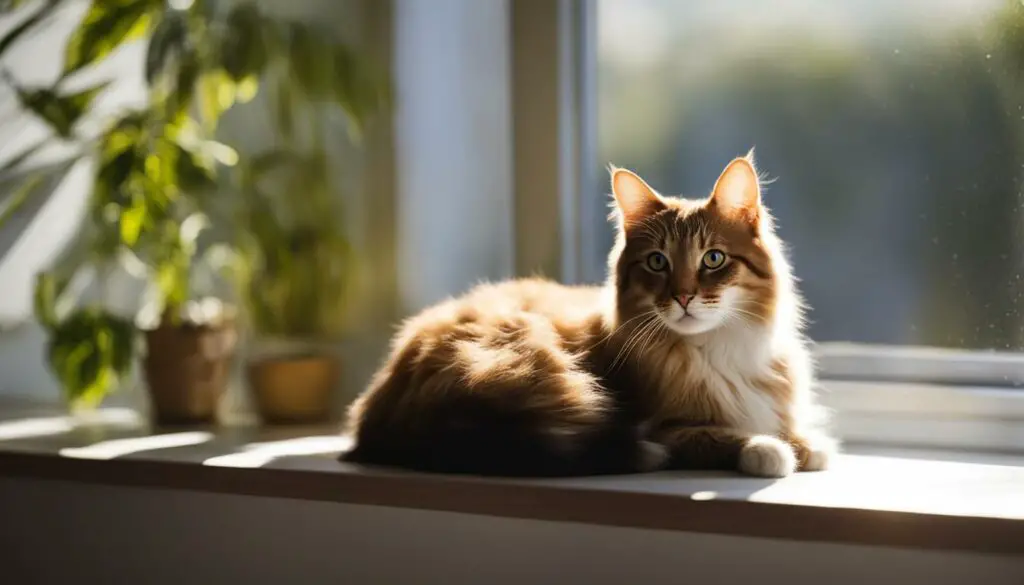
Key Takeaways:
- Sighing and huffing are two different vocalizations in cats.
- Sighing indicates relaxation and contentment, while huffing signifies irritation or anger.
- Recognizing these vocalizations can help cat owners understand their cat’s emotional state.
Sighing as a Sign of Happiness in Cats
Cats are known for their unique ways of expressing their emotions, and sighing is one of the ways they communicate their happiness and contentment. When a cat sighs, it is often a sign that they are feeling relaxed, comfortable, and enjoying their surroundings. It is a positive indication that they are in a good mood and feeling at ease.
Just like humans, cats can experience different emotional states, and sighing is a reflection of their inner state of happiness. It is commonly observed when a cat is in a peaceful and content mindset. You might notice your cat sighing after a long nap, during a cuddle session, or while basking in the sun. These are moments when they are most likely experiencing pure bliss.
Sighing is a natural behavior for cats and should be celebrated as a sign of their overall well-being. It is important, however, to consider other signs and behaviors in conjunction with sighing to fully understand your cat’s emotional state. By paying attention to their body language, purring, and other forms of communication, you can deepen your bond with your feline companion and ensure their happiness and contentment.
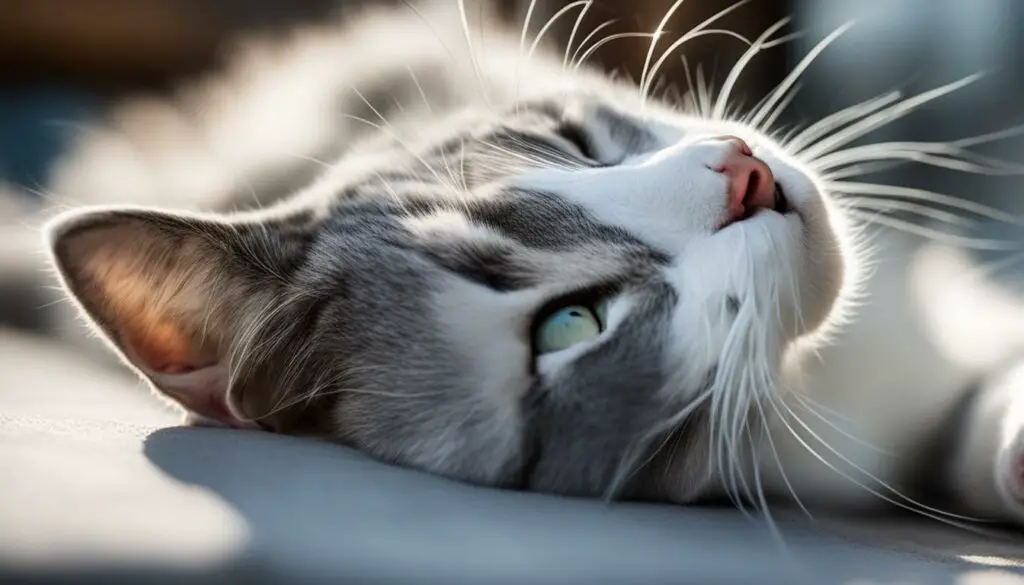
As responsible cat owners, it is our duty to create an environment that promotes our cats’ happiness and well-being. Providing them with a comfortable and enriching living space, engaging in interactive playtime, and offering plenty of affection can all contribute to their overall happiness. When you see your cat sighing, take it as a sign that you are doing a great job in providing them with a loving and nurturing home.
Cat Vocalizations: Understanding the Sounds Your Cat Makes
When it comes to communication, cats have a wide range of vocalizations that they use to express themselves. From meowing to purring, chirping to hissing, these sounds can convey various emotions and messages. Understanding cat vocalizations can help you decipher what your feline friend is trying to communicate.
One of the most common vocalizations that cats make is sighing. While sighing is often associated with relaxation and contentment in humans, it can have different meanings for cats. When a cat sighs, it could be a sign of contentment or a way to release tension and stress. It is important to observe your cat’s body language and other behaviors to interpret the meaning behind their sighs.
| Vocalization | Meaning |
|---|---|
| Meowing | Cats use meowing to communicate with humans. It can signify various messages, such as hunger, attention-seeking, or simply greeting. |
| Purring | Purring indicates relaxation, contentment, and pleasure. Cats often purr when they are being petted or when they are in a comfortable environment. |
| Hissing | Hissing is a defensive vocalization used by cats when they feel threatened or agitated. It is a warning sign to stay away. |
| Chirping | Cats chirp when they are excited or when they see prey. It is often observed when cats are watching birds or small animals through a window. |
| Growling | Growling is a sign of aggression and is usually accompanied by other defensive behaviors, such as hissing or arching the back. |
It’s important to note that not all cats vocalize in the same way. Some cats may be chattier than others, while some may be more silent. Each cat has its own unique vocal repertoire, and it is crucial to pay attention to your cat’s individual communication style to understand their needs and emotions. Remember, vocalizations should always be considered in conjunction with other behavioral cues to get a complete picture of what your cat is trying to convey.
When to Worry About Cat Sighing
While cat sighing is generally a normal behavior, there are certain instances where it may be a cause for concern. If your cat is sighing constantly or excessively, it could indicate an underlying health issue or discomfort. It’s important to pay attention to other signs and behaviors exhibited by your cat to determine if further veterinary care is needed.
If your cat’s sighing is accompanied by changes in appetite, lethargy, coughing, sneezing, or any other unusual symptoms, it is recommended to consult a veterinarian. These could be signs of respiratory issues or other health problems that require medical attention. The veterinarian will be able to assess your cat’s health and provide appropriate treatment if necessary.
Additionally, if your cat’s sighing is accompanied by behavior changes such as aggression, hiding, or avoidance, it may indicate discomfort or stress. Cats can often exhibit physical signs of discomfort through their behavior, and sighing could be one of them. Consulting with a veterinarian can help identify the cause of your cat’s discomfort and provide guidance on how to alleviate it.

Table: Signs of Concern Regarding Cat Sighing
| Signs | Possible Causes |
|---|---|
| Constant or excessive sighing | Underlying health issues |
| Changes in appetite | Respiratory issues |
| Lethargy | Discomfort or illness |
| Coughing or sneezing | Respiratory issues |
| Aggression, hiding, or avoidance | Discomfort or stress |
It’s important to remember that as a cat owner, you know your cat best. If you notice any changes in your cat’s behavior, including excessive sighing, it’s always better to err on the side of caution and consult a veterinarian. They will be able to provide the necessary guidance and ensure the health and well-being of your furry friend.
Sighing and Cat Illness
While sighing itself is not usually a sign of illness, it is important to monitor a cat’s overall health and behavior. Sighing may occur more frequently if a cat is lying around more due to illness or pain. If a cat shows other signs of illness, such as lethargy or decreased appetite, it is recommended to seek veterinary care.
Some common cat illnesses that can cause respiratory issues include upper respiratory infections, asthma, and bronchitis. These conditions can lead to coughing, wheezing, and difficulty breathing, which may result in more noticeable sighing. If your cat’s sighing is accompanied by any of these symptoms, it is important to consult a veterinarian for a proper diagnosis and treatment.
| Common Cat Illnesses | Respiratory Symptoms |
|---|---|
| Upper Respiratory Infections | Nasal discharge, sneezing, coughing |
| Asthma | Wheezing, coughing, difficulty breathing |
| Bronchitis | Chronic coughing, wheezing, difficulty breathing |
It is important to note that not all respiratory symptoms will be accompanied by sighing, and not all sighing is indicative of an underlying health issue. However, if you have any concerns about your cat’s health or behavior, it is always best to consult with a veterinarian to ensure proper care and treatment.
Cats as Sentient Beings
When it comes to understanding our furry feline friends, it’s essential to recognize that cats are sentient beings capable of experiencing a wide range of emotions. Just like humans, they have their own unique ways of expressing their emotional state, and one of those ways is through sighing.
Sighing in cats can be a sign of contentment and relaxation. It often occurs when they are in a peaceful state of mind, feeling at ease in their environment. Just like how we humans sigh to release tension or express comfort, cats use sighing as a way to release their own stress and tension.
By recognizing cats as sentient beings with emotions, we can deepen our bond with them and provide them with the care and attention they need. Understanding their emotional needs and responding to them appropriately can help create a harmonious and fulfilling relationship between cats and their human companions.
Recognizing Signs of Cat Emotions
While sighing is just one indicator of a cat’s emotional state, there are other signs to look out for as well. Purring, relaxed body posture, kneading, and affectionate behavior are all signs that a cat is content and comfortable. By observing and understanding these signs, we can ensure that our cats are happy and well-cared for.
| Signs of Contentment in Cats | Signs of Discomfort in Cats |
|---|---|
| Purring | Restlessness |
| Relaxed body posture | Excessive hiding |
| Kneading | Changes in appetite |
| Affectionate behavior | Increased aggression |
By paying attention to a cat’s emotional cues, we can ensure their well-being and create a happy and fulfilling life for both them and us.

Cats Sighing Out of Boredom
When cats sigh, it can sometimes be an indication that they are feeling bored. Just like humans, cats need mental stimulation and engagement to prevent them from becoming restless or disinterested in their surroundings. Without appropriate mental stimulation, cats may resort to destructive behaviors or become lethargic. To ensure that your feline friend remains mentally stimulated and content, it’s important to provide them with activities and toys that engage their natural instincts.
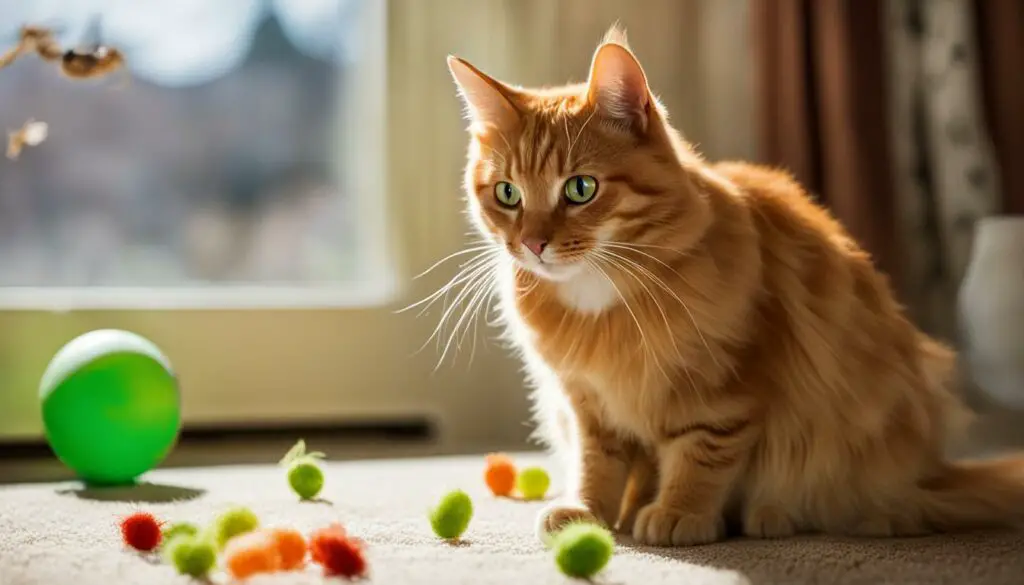
Providing Mental Stimulation
There are several ways to provide mental stimulation for your cat. Interactive toys, such as puzzle feeders or treat-dispensing toys, can keep them entertained while also encouraging problem-solving skills. Creating a stimulating environment with climbing trees, scratching posts, and hiding spots can also help alleviate boredom. Additionally, setting aside dedicated playtime with your cat using wand toys or laser pointers can provide them with the mental and physical exercise they need.
Signs of Boredom
It’s important to recognize the signs of boredom in cats. Apart from sighing, common signs of boredom include excessive sleeping, lack of interest in toys or surroundings, and increased vocalization. Cats may also engage in attention-seeking behaviors or become more destructive when they are bored. By identifying these signs, you can take the necessary steps to alleviate boredom and improve your cat’s overall well-being.
Summary
Cats may sigh out of boredom when they lack mental stimulation. Providing them with interactive toys, a stimulating environment, and dedicated playtime can help alleviate boredom and reduce excessive sighing. By keeping your cat mentally and physically engaged, you can ensure that they remain content and fulfilled in their daily lives.
The Significance of Cat Sighing
When it comes to cat behavior and emotions, sighing holds a significant meaning. Cats use sighing as a way to communicate their current mood and emotional state. While it may be tempting to dismiss a cat’s sigh as just another sound they make, it is important to pay attention to this behavior and the context in which it occurs.
Sighing in cats can indicate a range of emotions, including relaxation, contentment, and, at times, even boredom. Just like humans, cats experience different emotions throughout the day, and sighing is one of the ways they express these feelings. It is a vocalization that signifies their level of comfort and satisfaction in their environment.
Sighing in cats can be compared to a deep breath we take when we’re feeling at ease and content. It’s their way of releasing tension and showing that they are in a calm and peaceful state of mind.
While sighing is generally a normal behavior, it is essential to consider other signals and behaviors alongside it. If a cat is sighing excessively or in conjunction with other signs of discomfort or behavior changes, it may be worth consulting a veterinarian to rule out any underlying health issues. Monitoring a cat’s overall health and well-being is crucial for their overall happiness and quality of life.
The Emotional Language of Cats
Cats have their unique ways of expressing their emotions, and sighing is just one of the many vocalizations they use. Understanding their emotional language helps foster a deeper bond between cats and their human companions. By paying attention to their sighs and other vocalizations, we can better understand their needs and respond accordingly.
Understanding Cat Vocalizations
As cat owners, it’s important to understand the various vocalizations our feline friends use to communicate with us and express their needs and emotions. Cat vocalizations can range from purring and meowing to growling and hissing, each with its own unique meaning. By paying attention to these vocal cues, we can better understand and respond to our cats’ desires and emotions.
Cat communication is a fascinating aspect of their behavior. They use vocalizations to express a wide range of emotions, from contentment and happiness to fear and frustration. Understanding these vocalizations can help strengthen the bond between cats and their owners, as it allows us to interpret their needs and provide them with the appropriate care and attention.
Some common cat vocalizations include purring, meowing, chirping, growling, and hissing. Purring is often associated with contentment and relaxation, while meowing is a form of communication directed towards humans. Chirping is a unique vocalization often seen when cats are excited or trying to capture prey. Growling and hissing, on the other hand, are warning signs that a cat may be feeling threatened or aggressive.
“Understanding cat vocalizations is like learning a new language. It allows us to connect with our cats on a deeper level and respond to their needs effectively.” – Dr. Emily Jones, Feline Behavior Specialist
In addition to vocalizations, cats also communicate through body language, such as ear positions, tail movements, and facial expressions. Therefore, it’s essential to observe these cues in conjunction with vocalizations to gain a comprehensive understanding of a cat’s emotional state and intentions.

Table: Common Cat Vocalizations and Their Meanings
| Vocalization | Meaning |
|---|---|
| Purring | Contentment, relaxation |
| Meowing | Communication with humans |
| Chirping | Excitement, prey capture |
| Growling | Threat, aggression |
| Hissing | Warning, fear |
By familiarizing ourselves with the different cat vocalizations and their meanings, we can become more attuned to our cats’ emotions and respond accordingly. This understanding allows us to provide a nurturing and harmonious environment for them, helping to strengthen the bond between cats and their human companions.
Signs of Contentment in Cats
Cats are known for their unique behaviors and ways of expressing themselves. When a cat is content, there are several signs that indicate their happiness and relaxation. By understanding these signs, you can ensure that your feline companion is in a state of contentment and well-being.
Body Language
One of the key indicators of a contented cat is their body language. A relaxed and content cat will have a loose, relaxed posture. They may stretch out their body, exposing their belly as a sign of trust and comfort. Their ears will be in a neutral position, not tilted forward or backward, and their tail may be loosely curled or gently waving.
Another common sign of contentment is kneading. This behavior mimics the actions a kitten takes while nursing, and it signifies a feeling of security and happiness. Cats will often knead on soft surfaces, such as blankets or pillows, while purring softly.
Verbal and Physical Affection
Content cats may also exhibit verbal and physical affection. They may approach you with a relaxed body posture, rub against your legs, or even headbutt you gently. These actions are a way for cats to mark you as part of their territory and show their trust and contentment towards you.
Additionally, content cats may engage in grooming behaviors. They may groom themselves or even groom their feline companions as a sign of social bonding and affection. This behavior serves to strengthen relationships within a cat’s social group and indicates a sense of contentment.
| Signs of Contentment in Cats | Description |
|---|---|
| Relaxed Body Posture | A loose and relaxed body posture indicates contentment. |
| Kneading | Kneading on soft surfaces while purring signifies comfort and happiness. |
| Verbal and Physical Affection | Approaching with a relaxed body posture, headbutting, and grooming are signs of trust and contentment. |
Image source: https://seo writing.ai/32_6.png
Conclusion
After exploring the various aspects of cat sighing, it is clear that this behavior is a normal part of a cat’s repertoire. Cats sigh to express relaxation, contentment, and sometimes boredom. It is not usually a cause for concern and does not indicate any underlying health issues.
However, it is essential to pay attention to the context of the sighing and observe other behaviors and signs of discomfort. If a cat is sighing excessively or showing other signs of illness, it is advisable to consult a veterinarian to rule out any underlying health problems.
Understanding a cat’s emotions and needs is crucial for building a strong bond between cats and their owners. By providing mental stimulation, creating a stimulating environment, and being attentive to the cat’s vocalizations, we can ensure their wellbeing and happiness.
Remember, cat sighing is just one of the many ways cats communicate with us. By being observant and responsive to their needs, we can create a harmonious and fulfilling relationship with our feline companions.
FAQ
Why do cats sigh?
Cats sigh for various reasons, including relaxation, contentment, and boredom. Sighing is a normal behavior that indicates a cat’s emotional state. It is not usually a sign of underlying illness.
When do cats sigh?
Cats often sigh when they are relaxed and content. It can occur before or after sleep, as well as during periods of rest or leisure. Sighing is a way for cats to release tension and express their comfort.
Can boredom cause cats to sigh?
Yes, cats may sigh when they are bored. If a cat has nothing to do and is lying around, sighing may occur. It is important to provide cats with mental stimulation, such as climbing trees or puzzle toys, to prevent boredom and excessive sighing.
Is sighing a normal behavior for cats?
Yes, sighing is a normal behavior for cats. It is not usually a cause for concern and does not indicate any underlying health issues. Sighing is a sign that a cat is content in their environment.
Why do some cats sigh louder than others?
Some cats may sigh more loudly than others. This is usually not a cause for concern and is simply a variation in vocalization. Loud sighing may indicate that a cat is particularly relaxed and comfortable.
What is the difference between sighing and huffing in cats?
Sighing is a long, deep breath that indicates relaxation and contentment. Huffing, on the other hand, is a short, sharp breath that is often used to express irritation or anger. It is important to distinguish between the two sounds to understand a cat’s emotional state.
What does sighing in cats indicate?
Sighing in cats often indicates happiness and contentment. They may sigh when they are relaxed, comfortable, and enjoying their surroundings. It is a positive indication that a cat is in a good mood and feeling at ease.
Do cats use other vocalizations besides sighing?
Yes, cats use various vocalizations to communicate. Sighing is just one of the sounds they make. Other common cat noises include meowing, chirping, snarling, howling, hissing, moaning, and purring. Each vocalization has its own meaning and purpose in the cat’s communication repertoire.
Should I be concerned about my cat sighing?
In most cases, cat sighing is not a cause for concern. However, if a cat is sighing constantly, accompanied by other signs of discomfort or behavior changes, it may be worth consulting a veterinarian. Excessive or unusual sighing could potentially indicate an underlying health issue or discomfort.
Can sighing in cats be a sign of illness?
While sighing itself is not usually a sign of illness, it is important to monitor a cat’s overall health and behavior. Sighing may occur more frequently if a cat is lying around more due to illness or pain. If a cat shows other signs of illness, such as lethargy or decreased appetite, it is recommended to seek veterinary care.
Do cats have emotions?
Cats, like other animals, are sentient beings capable of experiencing emotions. They have their own unique ways of expressing their emotional state, including sighing. Understanding and acknowledging their emotions can help deepen the bond between cats and their human companions.
Why do cats sigh out of boredom?
Cats may sigh out of boredom when they do not have enough mental stimulation. Providing cats with toys, puzzles, and interactive playtime can help alleviate boredom and reduce excessive sighing. It is important to provide a stimulating environment for cats to keep them mentally and physically engaged.
What is the significance of cat sighing?
Cat sighing can provide insights into a cat’s current mood and emotional state. It is important to pay attention to other signals and behaviors in conjunction with sighing to understand the full picture. Cats have their unique ways of communicating, and sighing is just one of the many ways they express themselves.
How can I understand my cat’s vocalizations?
By understanding different cat vocalizations, including sighing, pet owners can better understand their cat’s needs and emotions. Each vocalization has its own meaning and can vary depending on the context. Being attentive to a cat’s vocalizations can help strengthen the bond between cats and their owners.
What are the signs of contentment in cats?
Signs of contentment in cats include purring, relaxed body posture, kneading, and affectionate behavior. By observing these signs, you can ensure that your cat is happy and comfortable in its environment.
Source Links
- https://www.hepper.com/why-do-cats-sigh/
- https://catvills.com/why-does-my-cat-sigh/
- https://askmycats.com/does-your-cat-sigh/

